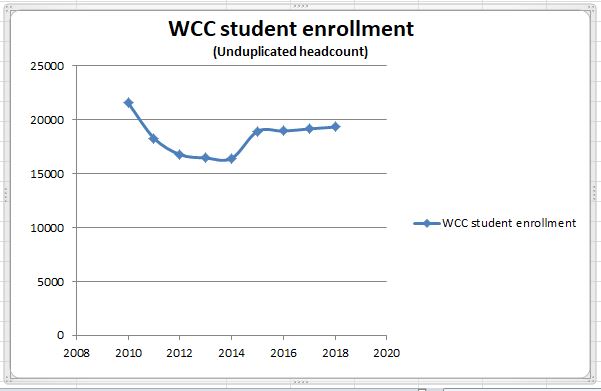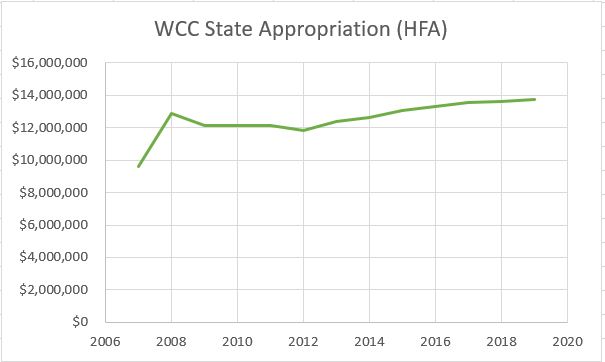Yesterday’s post looked at some of the issues surrounding the WCC Proposal 1 request to reauthorize a millage for operating purposes. Today, we’ll look at the WCC master plan and the deceptive way in which WCC presents its glowing financial picture to the taxpayers.
The master plan to build a hotel and conference center
WCC’s newly released Master Plan includes building a hotel and conference center on the campus. According to Trustee Richard Landau, the College would build and manage the building itself, while outsourcing the day-to-day management of the facility to a third-party. This approach – which WCC uses to operate the Health and Fitness Center – is fundamentally flawed. The Health and Fitness Center – paid for with revenue-backed debt – requires the diversion of millions of operational dollars each year to pay the building’s loan debts and its enormous maintenance costs. The building, which was opened in 2007 must be oversubscribed in order to generate enough revenue to stay ahead of its costs.
A hotel property is pure maintenance and generates very slim profit margins – even in good years. In bad years, hotels operate at a loss. Based on WCC’s master plan, the College will divert the county’s education tax dollars to pay for hotel and conference center operations, maintenance and debts – including those years when the hotel must operate at a loss.
Aside from this, certain Trustees are eager to use WCC’s tax appropriation to solve Ann Arbor’s “convention center problem.” Various constituencies around Ann Arbor have advocated for a convention center for more than 30 years. WCC Proposal 1 asks voters to decide whether they want WCC to build a convention center using the College’s operating expenses.
Non-essential construction comes with an opportunity cost. 50, 30 or even 10 years from now, we may need that land for academic buildings. Further, some of the proposed “retail outlots” are in the WCC parking lots. The parking lots do not represent excess capacity or unused space. WCC’s enrollment can jump by 20%-25% during a recession. Each one of those empty spaces will get used, provided they’re not occupied by a Starbucks.
Deceptive presentation of WCC’s revenues
According to WCC President Rose Bellanca, WCC needs a hotel and conference center to replace revenue from declining enrollment. In fact, WCC is operating from the largest budget in its history, and its enrollment is remarkably stable.

Further, the President claims that a drop in the area’s school-age population will impact enrollment for the foreseeable future. Once again, the facts are not cooperating. The Southeast Michigan Council of Governments (SEMCOG) and the United States Census Bureau both predict that Washtenaw County’s school-age population will increase by 10% in the coming years. Additionally, WCC enrolls adults of all ages. A decline in the school age population might have little to no impact on WCC’s enrollment.
The WCC administration ludicrously claims that WCC’s state appropriation has dropped from its peak of 37% in 1970 to a mere 14% of WCC’s overall revenue picture today. While the percentages are correct, the state appropriation (in dollars) has decreased only once in the last decade.

In inflation-adjusted dollars and using House Fiscal Agency figures, WCC receives 16.5% more money from the state than it did in 2007. The administration is merely playing games with percentages. WCC’s other revenue sources are simply growing faster than its state appropriation is.
WCC will collect nearly $59M in county tax revenues this year alone – the highest in its history. WCC collects more county tax revenues for operations than all but Oakland CC and Wayne County CC. Further, WCC’s revenue from tuition and fees has increased, even as its enrollment has declined. WCC does not have a revenue problem. It has a spending problem – one that starts at the top.
WCC Proposal 1 question is about more than keeping the lights on
The new WCC master plan represents a fundamental shift in WCC’s purpose from education to real estate development. It also indicates that this administration has given up on WCC’s educational mission in favor of revenue generation.
Making money is not WCC’s fundamental purpose. And it is ridiculous to suggest that WCC – with its $112M budget – is somehow hurting for revenue. If WCC needs more revenue, it is to paper over the stunningly poor financial decisions its administration has made, and its Board of Trustees has mindlessly approved. Ultimately, WCC Proposal 1 asks voters choose whether they want WCC to use its tax appropriation to focus on education or to gamble on speculative real estate ventures.
This move to real estate development is a risky strategy. It has the potential to stick the taxpayers with enormous long-term debts. Worse, it can destabilize WCC’s finances during a recession – exactly when we need WCC firing on all cylinders.
WCC Proposal 1 asks voters to decide whether they’re OK with the WCC administration deliberately twisting the facts about the College’s revenues, and its current and projected enrollments. As a rule, I’m not a big fan of being lied to, especially when the lies rationalize huge construction projects.
Tomorrow, we’ll look at how WCC plans to finance its growing debt burden, and the unrestrained growth of the administration since Rose Bellanca arrived on campus.
Photo Credit: Rodrigo Suarez, via Flickr
















